Frédérique Baumgartner
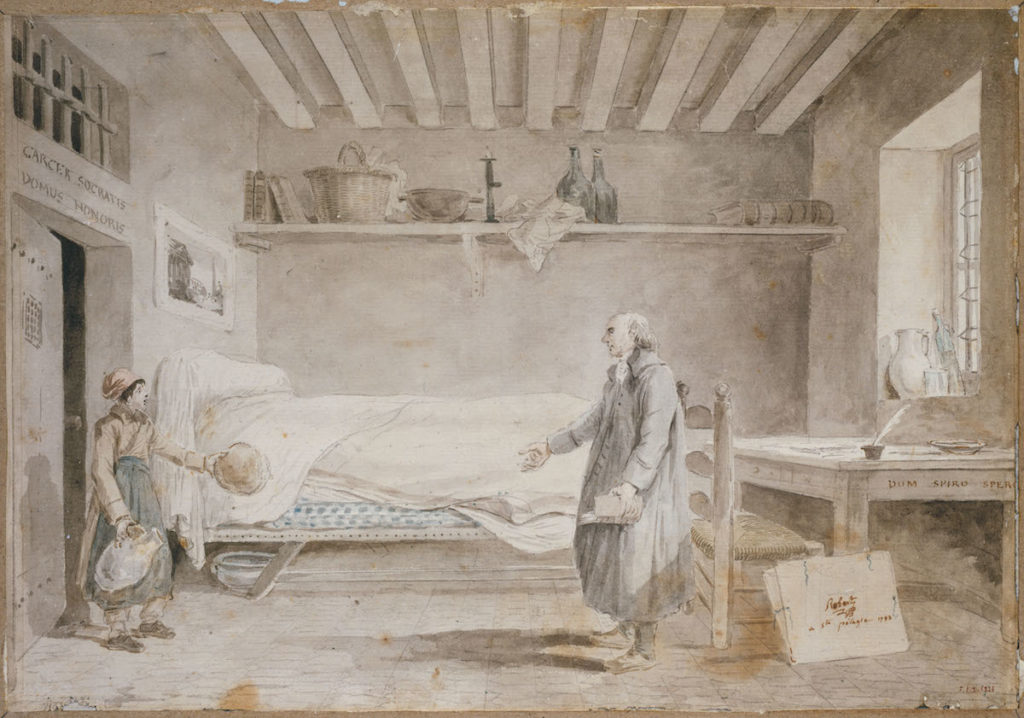
The identity of the aging man in profile, wrapped in a long grey coat, in the drawing entitled The Artist in His Cell (Fig. 1) cannot be mistaken.[1] The man’s receding forehead, advanced baldness, tuft of grey hair at the nape of his neck, and thick black eyebrow instantly allow us to recognize Hubert Robert (1733-1808) as the prisoner whose reading has just been interrupted by the arrival of a young person bringing him sustenance. These facial features are present in other portrayals of the artist, including Élisabeth Vigée Le Brun’s 1788 effigy of her long-time friend, painted while the two artists were enjoying some time as guests of Claude-Henri Watelet at Moulin-Joli (Fig. 2). Robert’s physical traits in this well-known portrait, echoed in the drawing, were also recorded in writing in the prison register at the time of his arrest, that is, when The Artist in His Cell was drawn: “gray hair, black eyebrows […] square and bare forehead.”[2]
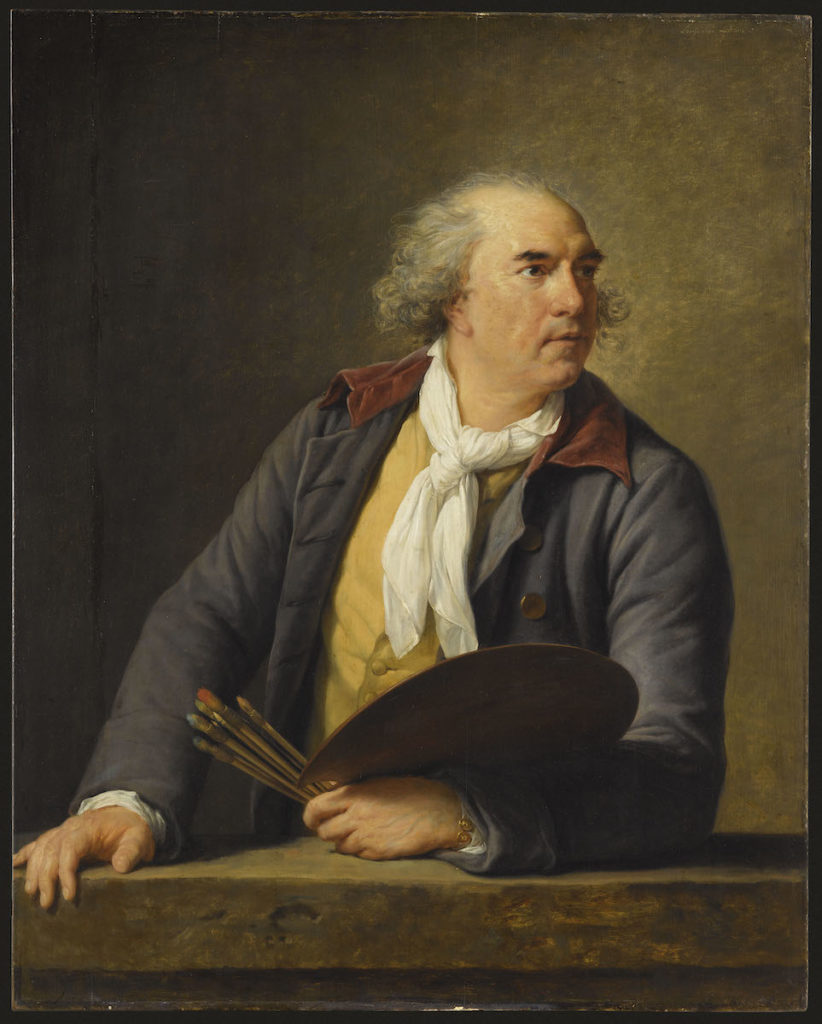
Indeed, like hundreds of thousands of individuals during the period of the French Revolution known as the Terror, Robert experienced captivity between 1793 and 1794.[3] Some of these prisoners, Robert included, were actually not politically active people. Yet for reasons ranging from social privilege to suspicious friendships, they were perceived as a threat to the success of a young Republic aware of its own precariousness. According to the latter’s devoted leaders, the multiplication of arrests and, worse, hasty beheadings, became a matter of safeguarding the Revolution. It is in these circumstances that Robert found himself in prison and, by extension, as the main protagonist in The Artist in His Cell. Importantly, Robert, whose nine-month ordeal ended with his liberation, is not only present in the drawing through facial features resembling his presumed physical appearance. Two motifs, diametrically opposed in the composition and pointing to his status as an artist, confirm his identity: on the left, decorating the wall, a view of ancient monuments epitomizing the “painter of architecture’s” artistic production;[4] and on the right, leaning against the table leg, a portfolio bearing his signature, “Robert,” followed by his whereabouts, “a [sic] ste pélagie”—the Parisian prison where the artist was first detained before being transferred to Saint-Lazare prison a few months later. The year, “1793,” also appears. Robert is not only the prisoner depicted in the cell, he is also the author of the drawing.
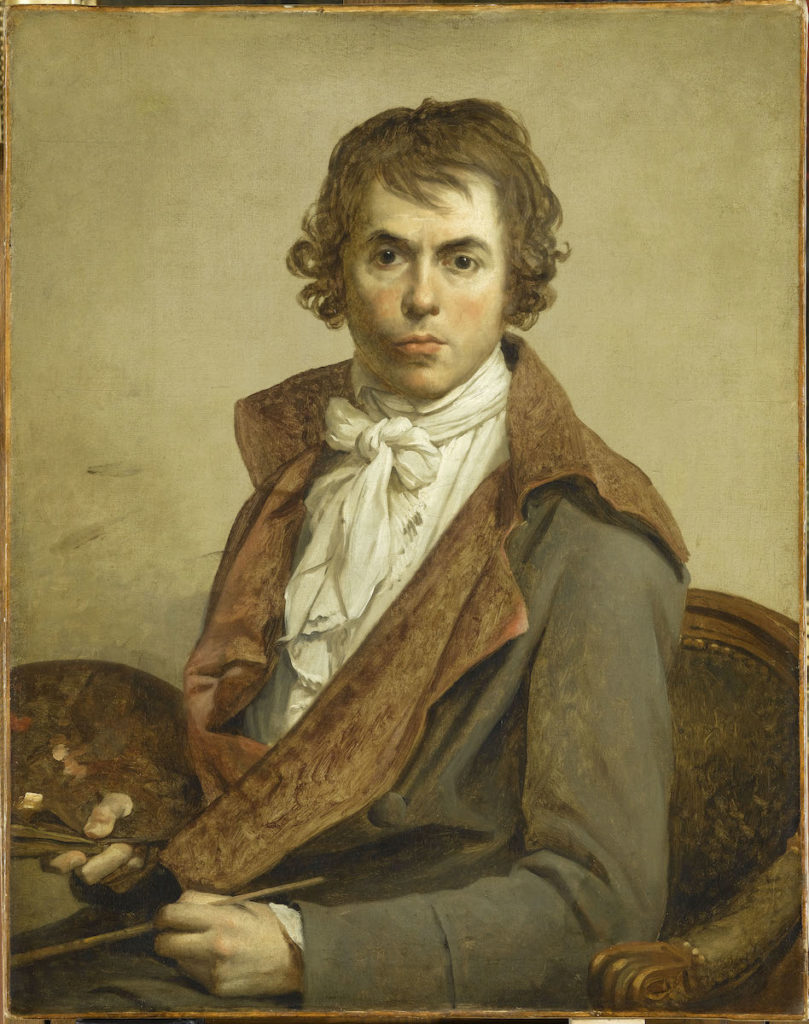
While Robert is featured unequivocally in The Artist in His Cell, the drawing differs from seemingly more straightforward representations of selves by artists, including Jacques-Louis David’s Self-Portrait from 1794 (Fig. 3), also painted in a Parisian prison, but in the aftermath of the Terror. Unlike Robert, David’s imprisonment was due to his deep involvement in revolutionary politics. As Ewa Lajer-Burcharth has argued, his self-image, completed shortly after the execution of Robespierre, reveals the degree to which the representation of his own body could not be left intact from traces of what was now decidedly his political past.[5] Most importantly, in light of this journal issue’s concern with “expanded definitions of both the ‘self’ and the ‘portrait’,” David’s painting may expand notions of the former, but not the latter, as the artist uses the most elementary conventions of self-portraiture as a long-standing genre in French painting: a neutral background showcases a seated, frontal figure in three-quarters, whose individualized features, contemporary dress, attributes, and direct gaze come together to express the sitter’s physiognomy, social status, and psychology.
Robert’s drawing, by contrast, offers an expanded take on both the self and the portrait, and does so without drawing on the usual conventions of self-portraiture as a genre. The Artist in His Cell functions primarily as the image of a prison cell, whose inmate is Robert. The chosen point of view offers optimal insight into the layout and furnishing of the space. Represented parallel to the picture plane but at a certain distance, one is to assume that the majority of the cell is depicted. The lateral walls, delimiting the edges of the composition, include details that hint at the space’s confining function: the left wall features a heavy door, left ajar by Robert’s visitor, with a small grated opening that provides a means of restricted communication between prisoner and guard. Above the door, a larger opening, protected by thick bars, firmly establishes the space as a prison cell, as does the crisscrossed pattern discernible on the exterior window depicted on the opposite wall. In line with the conception of the cell as a space serving a specific function, the narrative taking place—a loaf of bread and some beverage delivered to a prisoner confined in his cell—is emblematic of the routine of prison life. The rudimentary pieces of furniture and objects that fill the rest of the composition also highlight the basic needs and activities of a prisoner: a bed and a chamber pot; a chair, a desk, and an inkwell; and a shelf for books and other items, including a basket, a candlestick, and various utensils, some also placed on the ledge of the barred window.[6]
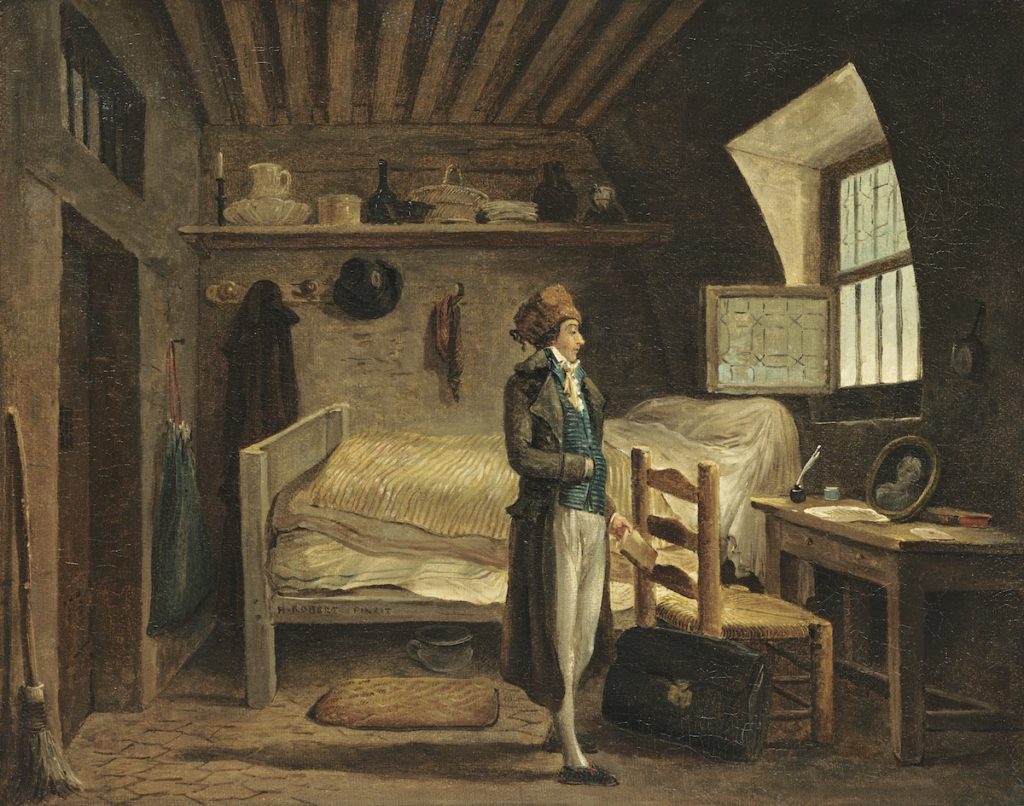
Looking at this snapshot of daily existence in a revolutionary prison, delivered through a slightly hesitant hand favoring grey tones (except for a few accents of washed out primary colors), the first words of a letter from the poet Jean-Antoine Roucher (1745-1794) to his wife come to mind. The letter, dated 7 Frimaire Year II (November 27, 1793), is contemporary to Robert’s stay at Sainte-Pélagie, where Roucher was also detained at the time: “You cannot see my cell, and you want to know it. I will try to show it to you.”[7] Roucher’s subsequent description mentions details appearing in The Artist in His Cell, including the tile flooring, straw chair, and high bed, which are also elements visible in a painting by Robert that is believed to represent Roucher in his cell at Sainte-Pélagie (Fig. 4).[8] In it, the poet is depicted standing in profile at the center of a composition closely resembling The Artist in His Cell. Like the latter, the painting known today as Jean-Antoine Roucher in Prison draws on space, ordinary objects, and personal possessions to relay the experience of a captive self.[9]
Robert’s expanded approach to (self-)portraiture, with the cell serving to mirror his identity at this particular moment, comes as no surprise in light of his larger oeuvre. While the human figure (not the artist’s forte according to Diderot) pervades his compositions, portraiture in the strict sense is conspicuously absent from his otherwise extremely diverse body of work. The Artist in His Cell and other works by Robert focusing on everyday life at Sainte-Pélagie have been described as “genre scenes.”[10] Though he depicted such scenes from time to time throughout his career, Robert practiced this genre with particular intensity during his incarceration, when he showed an unprecedented attention to the representation of his own present condition.[11] Both The Artist in His Cell and Jean-Antoine Roucher in Prison include a light source coming from a lateral window and a wealth of details offering insight into the realities of prison life, and both evoke seventeenth-century Flemish interior genre scenes. However, they are fundamentally different in terms of the inscription of individuality: unlike the figure in the drawing, the identity of the man in the painting actually cannot be established with certainty.
In this essay, I examine how Robert’s self-inscription in The Artist in His Cell is crucial for understanding his view on the relationship between the self as a visual artist and an escalating Revolution. By extension, the drawing offers insights into shifts around artistic identity in light of the profound anxiety that the figure of the individual, a cornerstone of Enlightenment and revolutionary thought, sparked among political leaders during the Terror. Emphasizing the drawing’s distance from more traditional forms of self-inscription in Robert’s non-prison oeuvre, I argue that The Artist in His Cell embodies the artist’s reevaluation of the self following the enactment of the Law of Suspects on September 17, 1793. This law, as I will show, identified the individual as the antithesis of the citizen. As such, Robert’s drawing brings into focus the existence of allegedly conflicting forms of subjectivity during the most troubled years of the French Revolution. More specifically, it highlights the implications of changing judicial conceptions of identity around 1793 on Robert’s sense of self as a creative individual.
The “dissemination of the presence” and its disruptions
The existing scholarship on the art Robert produced in prison following his arrest on October 29, 1793—a period in which he remained remarkably active as an artist[12]—shows that the identity of the figures appearing in his prison oeuvre has continuously preoccupied and divided art historians. While there are compelling reasons to believe that the prisoner represented in Jean-Antoine Roucher in Prison is indeed the poet, disagreements persist in the case of other works.[13] The Artist in His Cell, by contrast, is not ambiguous in the least.
The viewer’s immediate recognition of the aging man as Robert in The Artist in His Cell should not be ascribed only to the artist’s facial features, but also considered in light of what Charlotte Guichard has recently characterized as “the dissemination of the presence [of the artist]” in Robert’s oeuvre.[14] As Guichard has shown, Robert’s conscious and recurring self-inscription in his compositions deployed itself in multiple ways, including strategically placed signatures and Latin phrases combining scholarly and personal references, written with a touch that highlights the artist’s gesture. Such tangible traces of the artist also appear in our drawing: in addition to the signature on the portfolio through which Robert claims his authorship of the drawing, two phrases are visible: “Carcer Socratis Domus Honoris” (“Socrates’ prison is the house of honor”) above the door, and “Dum Spiro Spero” (“As long as I breathe, I hope”) on the frame of the table. As Sarah Catala and Catherine Voiriot have pointed out, these Latin expressions were commonplace in Robert’s time;[15] and considering the artist’s own condition as a prisoner, they also hold the personal content that Guichard has noted.
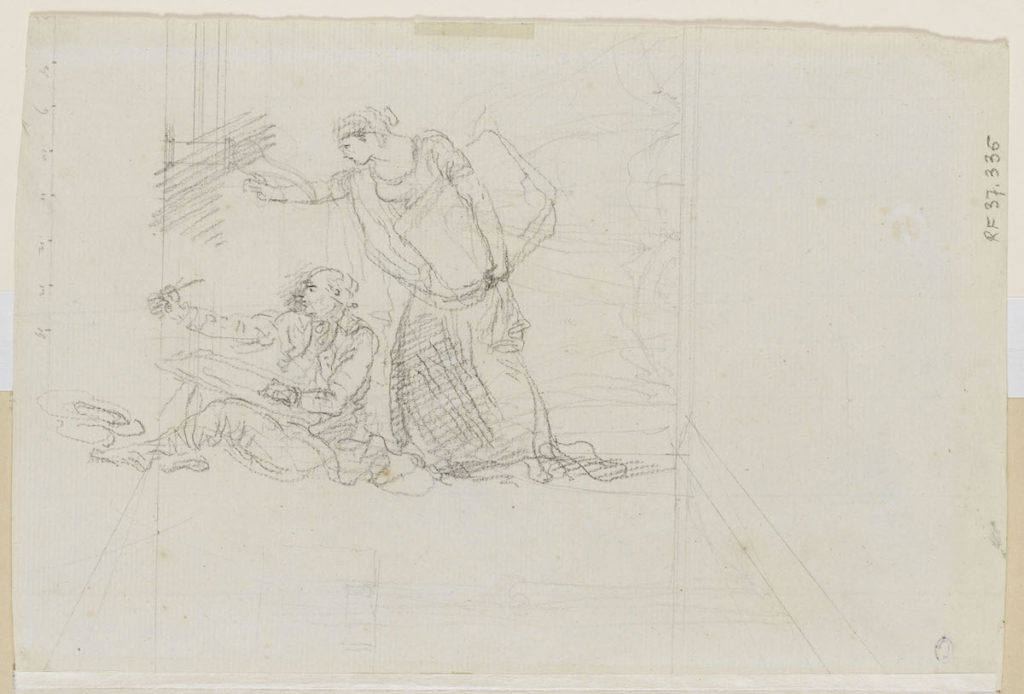
That being said, the most obvious component of self-inscription in Robert’s oeuvre—the motif of the seated artist at work, a pencil in hand wandering across a sheet of paper, his gaze directed towards the object being represented—is notably absent. First appearing in the artist’s Roman works (for example, The Draughtsman at the Capitoline Museum (c. 1762) in the collection of the Musée de Valence), this motif resurfaced throughout his oeuvre. His late production is no exception, as evidenced by examples as varied as the quick sketch known as Seated Draughtsman Taking Measurements, and Woman Standing Behind Him (Fig. 5),[16] and the ambitious painting entitled Project for the Transformation of the Grande Galerie from 1796, which features the balding artist conscientiously copying Raphael’s Holy Family (Fig. 6).[17] The Artist in His Cell contradicts these examples insofar as it abandons the image of the artist as a person engaging in the creative act. Indeed, markers of Robert as a draughtsman, while present, are relegated to the margins of the composition and put to rest. Palpable creativity is in fact brought to a halt in the prison drawing—arrested in time and space, like Robert himself, standing still in his cell, holding a book instead of a pencil, and greeting his guard instead of carrying his portfolio.
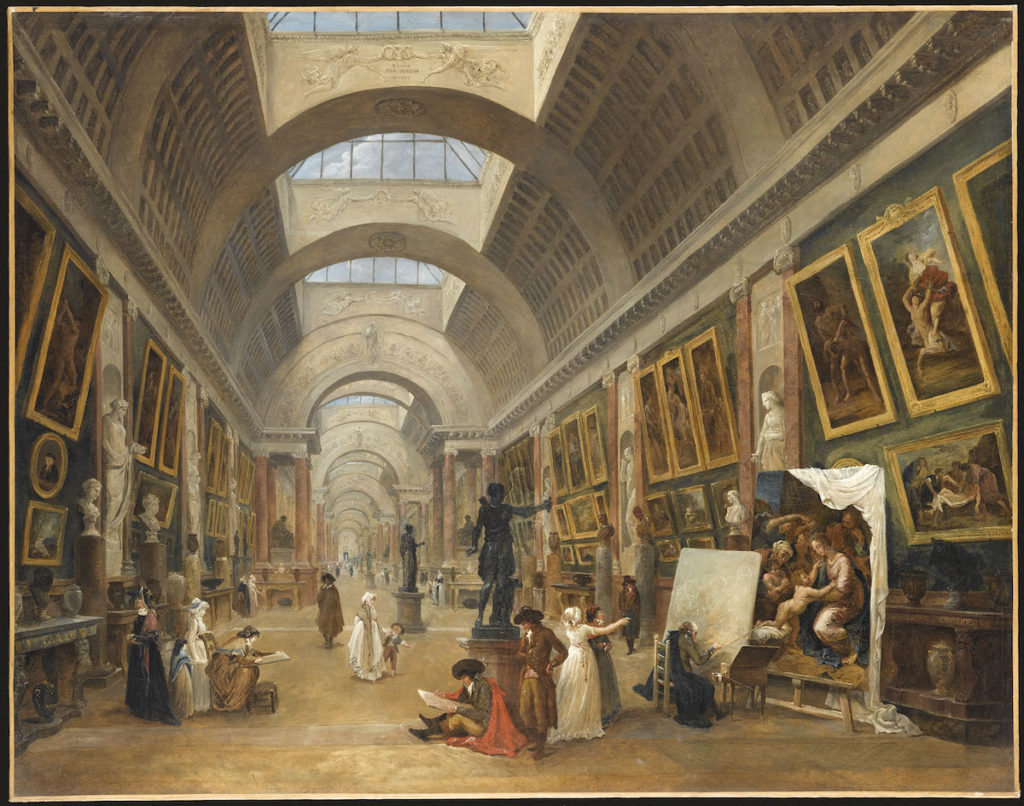
The transformation of Robert’s approach to his artistic presence during his time in prison is evident in a comparison of The Artist in His Cell with the painting entitled Artist in a Studio (c. 1763-1765) (Fig. 7). The light source, representation of space, placement of the artist, and to some extent the furnishings are remarkably similar in both works; yet the signs of artistic creation are activated very differently. For Guillaume Faroult, who recognizes Robert in the artist depicted in the painting, one of the most significant qualities of the composition is its lack of solemnity. It is as though the presence of the artist (presumably in a room of the Palazzo di Malta where the Bailli de Breteuil welcomed Robert towards the end of his Roman stay) disrupted the space.[18] However, when compared with The Artist in His Cell, the signs of creative frenzy become the most prominent trait of the painting. One sees a very casually dressed Robert sitting on the edge of his chair, his portfolio leaning against it, fervently copying a bust. The painting’s rapid and bold brushwork, especially for the clothing, signals the creative passion animating the artist, whose uncontrollable productivity radiates throughout the studio: the back wall is covered with carelessly hung sketches, as though the artist’s urge to create did not grant the time to arrange his art more carefully. The crumpling of the large piece of cloth covering his work table and the pieces of paper and objects haphazardly placed on the desk by the window also contribute to the sense of a creative wind blowing through the room, emanating from Robert himself. The art may fall from the wall, the dog may get a hold of the slippers—none of it can stop the artist’s frantic activity.[19] Viewed from this perspective, Artist in a Studio becomes the reverse image of The Artist in His Cell: the latter a deactivated scene with little graphic brio, showing a tidy, inert space, where the portfolio, as well as the quill and sheet of paper on the desk, are removed from the artist’s body.[20] In addition, the drawing presiding over the bed, whose subject matter recalls Robert’s artistic output prior to his captivity, points to a time of creation located in the past rather than in the present.
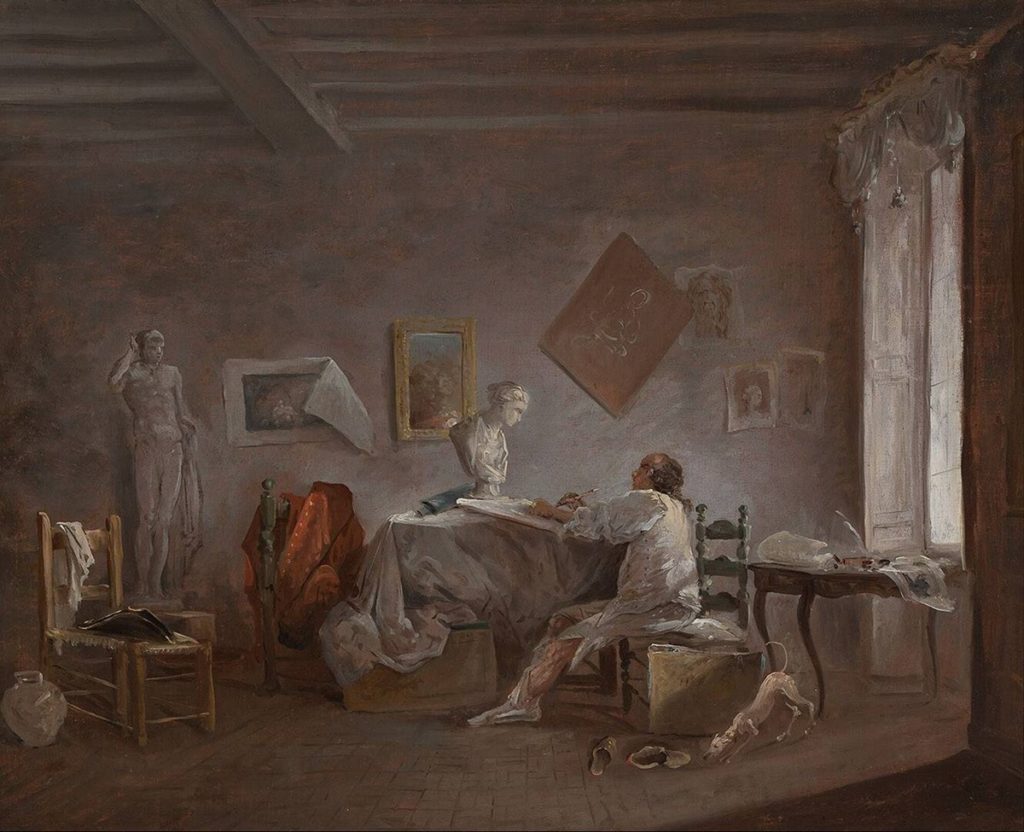
There is, nonetheless, a paradox, as the existence of The Artist in His Cell testifies to Robert’s creativity during his imprisonment. In this respect, the artist’s production at Sainte-Pélagie and later at Saint-Lazare—marking a shift in his choice of subject matter with the emergence of prison imagery—can be seen through the same lens as the one described by Daniel Sangsue with regard to Xavier de Maistre’s A Journey Round my Room, where “writing is at once activated and limited by confinement.”[21] Similarly, in The Artist in His Cell, Robert produces an image of suspended creativity, contained within the laboriously articulated space of the cell and materializing through the tentative contours of the two bodies, his own frail silhouette casting a shadow dissolving into a formless stain on the paved floor. The drawing is painfully deprived of “wall power.”[22]
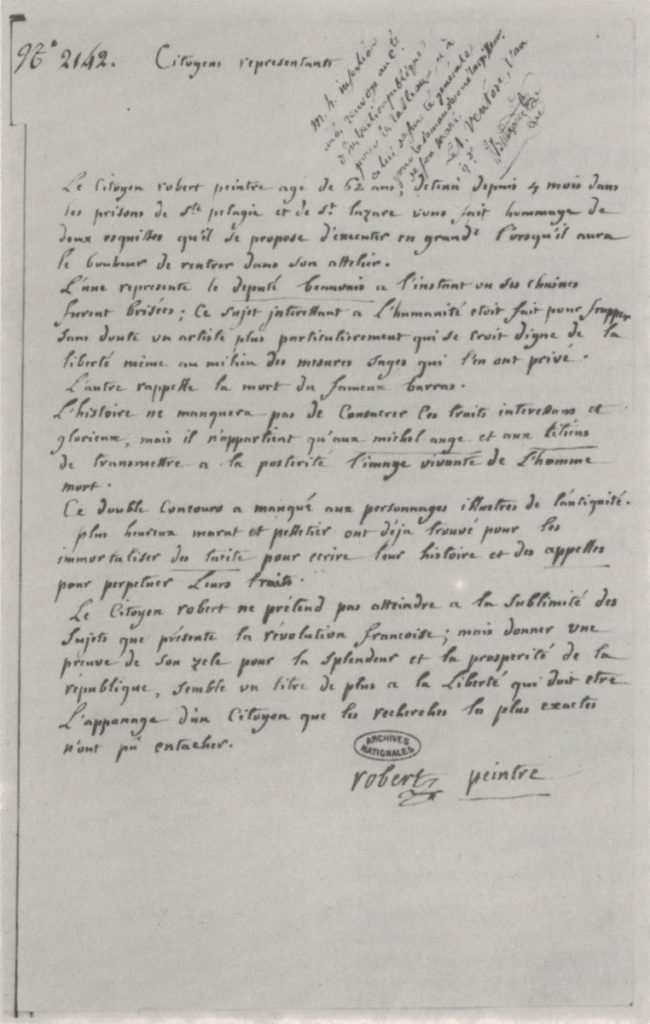
In leaving behind a form of self-inscription that had relied most heavily on the image of the artist at work, Robert’s sense of self in The Artist in His Cell comes across as dramatically altered. Who is Robert without a pencil in hand? A mere prisoner with the same needs as any other prisoner, as suggested by the compositional resonance of this drawing with Jean-Antoine Roucher in Prison. In this context, the letter that Robert sent to the National Convention from Saint-Lazare prison around February 1794 demonstrates the degree to which he was aware that the reactivation of his artist-self would require the public assumption of a new form of artistic identity (Fig. 8). In this letter, Robert proposed that he would produce two paintings of revolutionary martyrs on the condition that he be freed. He did not explicitly write that he wished to exchange the paintings of Charles-Nicolas Beauvais de Préau and Joseph Bara respectively for his freedom, but implied it by stating that the large canvases could only be painted from his studio. He concluded his letter by reminding the Convention that no evidence of any counter-revolutionary activity on his part had been found.[23] Robert’s stratagem failed: he never received any reply to his letter, though the minutes from the Convention attest that on February 19, 1794, sketches were presented there by Madame Robert. Following her intervention, they were sent to the Committee of Public Instruction, while the request for Robert’s liberation was sent to the Committee of General Security.[24] Nothing happened after that.
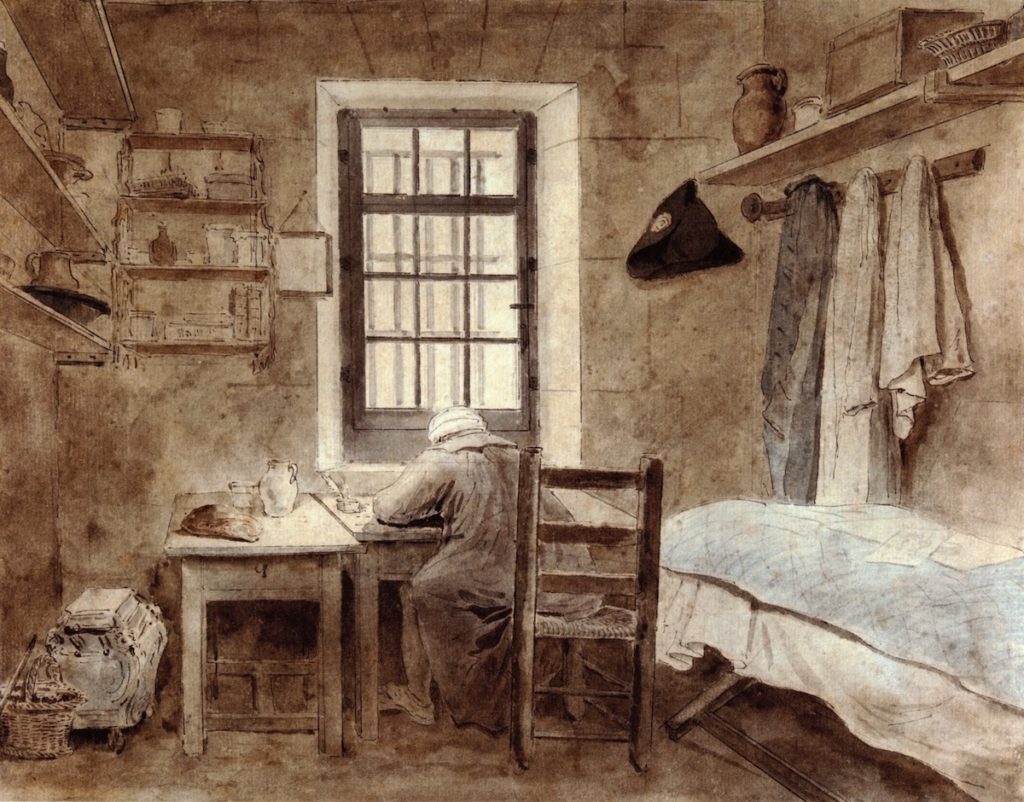
Robert’s attempt indicates that the idea of the artist following his inspiration freely, epitomized by Artist in a Studio, was no longer sustainable. Instead, he had to embrace the model of the artist-patriot, brilliantly incarnated by David, to whom he referred in his letter, and who had himself declared in August 1793: “Love of humanity, liberty, equality, animate my paintbrushes.”[25] With these words, David was wholeheartedly relinquishing his artistic agency to entrust revolutionary values with the making of his art. More modestly, Robert’s letter, prompted by his bleak circumstances, was an effort to respond to the revolutionary government’s recent call to artists to portray revolutionary martyrs.[26] Importantly, nothing in The Artist in His Cell suggests Robert’s attachment to the Revolution. Jean-Antoine Roucher in Prison, by contrast, shows on the coat rack a hat featuring a tricolor cockade that also appears on the tricorn featured in another Robert drawing of a prisoner in his cell (Fig. 9). However, nothing indicates any anti-revolutionary sentiment on the part of the artist either. That is not to say that Robert welcomed his captivity (who would?), but rather, that the drawing is not taking a political stance, as the two Latin inscriptions—essentially universal statements on the need for optimism in the face of imprisonment—also imply.[27] In fact, this is consistent with the artist’s complete absence of involvement in politics per se throughout the Revolution. This differentiates him, for example, from Roucher, a moderate who belonged to the Club of the Feuillants. As such, the role of Robert’s unthreatening visitor in The Artist in His Cell, his head covered with a liberty cap (which, along with the date written on the portfolio, situates the drawing historically), is not to argue for or against the Revolution, but to emphasize Robert’s status as a prisoner instead of an artist at work.[28]
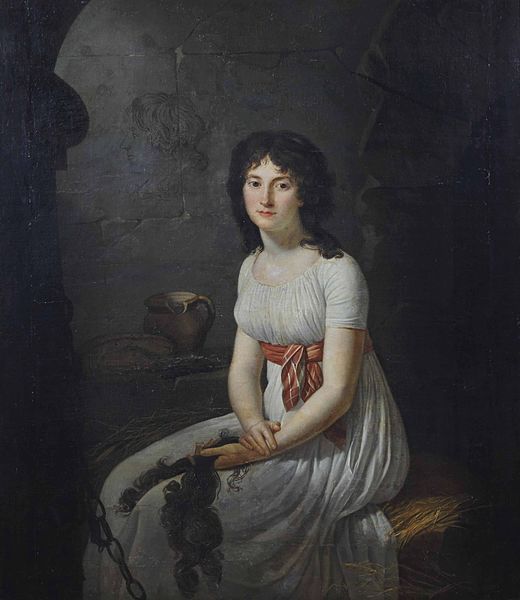
In this respect, The Artist in His Cell functions very differently from Jean-Louis Laneuville’s The Citoyenne Tallien in a Prison Cell at La Force, Holding Her Hair Which Has Just Been Cut (Fig. 10). As Amy Freund has argued, this romanticized portrait from 1796 showed how “Cabarrus [the Citoyenne Tallien], by embracing [a] masculine aesthetic and inserting herself into a politically charged narrative, deliberately appropriated conventions that had been eagerly adopted by male commissioners during the Revolution.”[29] Cabarrus’ portrait, like countless others produced between 1789 and 1804 (the chronological frame of Freund’s book), thus participated in what the author has described as “the fundamental challenge of the Revolution: how to make subjects into citizens.”[30] In other words, the portrait, painted after the fall of Robespierre and exhibited at the Salon of 1796—two crucial differences from Robert’s drawing[31]—was a public statement on the new political agency injected into subjects as part of the Revolution’s redefinition of the political sphere. Female and male subjects, however, were certainly not equal in their right to participate in this effort.
Significantly, Cabarrus is portrayed as “a unique and intact self.” Even though she appears “caught in a situation designed to erode and eventually destroy that self,”[32] at the time of the making of the portrait, she was no longer threatened by the guillotine and had resumed her political activities. By contrast, The Artist in His Cell portrays an artist who never, strictly speaking, took part in political debates. Moreover, it was drawn when Robert’s life was very much at risk and, equally important, it was not intended for public display. (None of Robert’s prison works were ever shown at the Salon.)[33] The Artist in His Cell highlights first and foremost the artist’s private reflection on his designation as a “suspect” in 1793. Prompting at once a reevaluation of his status as an individual and as a citizen, Robert’s newly assigned identity of suspect, responsible for his fate as a prisoner, led him to abandon his representation of the self as an inspired artist—what had defined his identity to date. Instead of the “unique and intact self,” which Cabarrus assumed in 1796, Robert’s fading figure, blending with its surroundings—a visual counterpart to Roucher’s phrasing, “I am paved in stone slabs,” when he described his cell[34]—presents the image of a self merging with the persona of the prisoner.
Citizen, individual, suspect
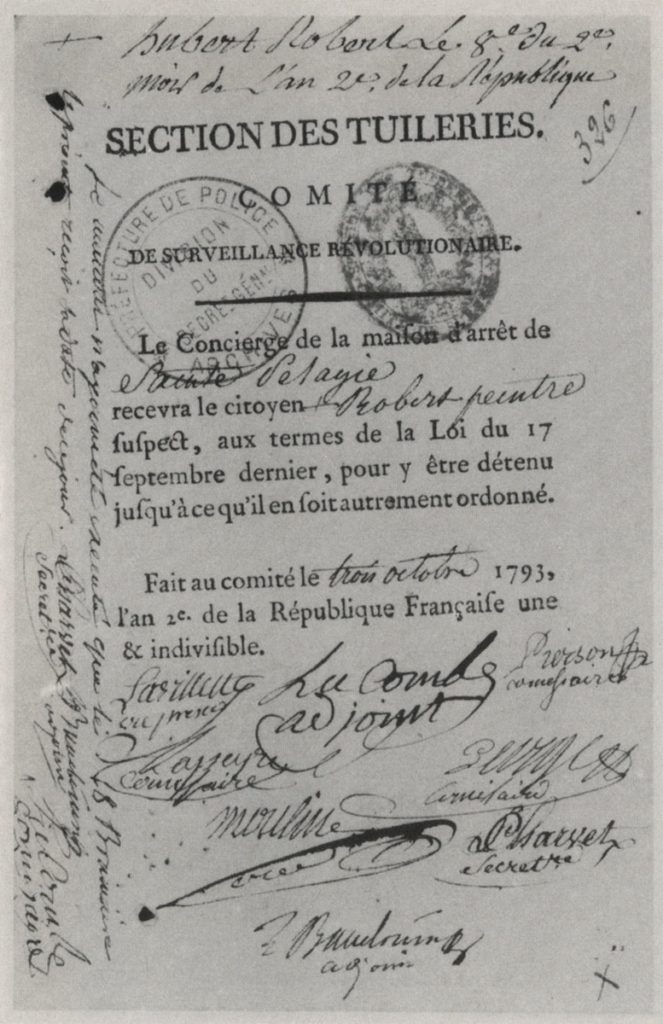
Robert was arrested according to the Law of Suspects, as indicated on his warrant which was issued by the Committee of Revolutionary Surveillance of the Tuileries Section on October 3, 1793, and carried out on October 29 of the same year (Fig. 11).[35] The official reasons for the artist’s arrest were recorded in vague terms in a second document, dated October 29, 1793: “His known absence of civic-mindedness, his connections with the aristocrats.”[36] These faults appear in the text of the Law of Suspects (actually a decree), though phrased somewhat differently.[37] Reviewing Robert’s biography, one can identify episodes that suggest such flaws. For example, when the Commune des Arts, in the wake of the abolition of the Royal Academy of Painting and Sculpture on August 8, 1793, invited ci-devant Academicians on September 24 to come burn their academic titles, Robert waited ten days to comply, whereas many of his colleagues performed this patriotic gesture immediately.[38] As far as “connections with aristocrats” are concerned, Robert’s relationships with numerous “compromising amateurs,” to use Jean de Cayeux’s term, are widely documented (and the artist was reunited with many of them in prison).[39] His suspicious relationships extended to the Crown, as epitomized in the patronage of the loathed Marie-Antoinette, whose trial opened days after Robert’s warrant. However, rather than drawing on Robert’s biography—which actually indicates that no incriminating facts were identified when the Committee of Surveillance of Auteuil investigated him in May 1794[40]—examining the language used in the decree seems more helpful for understanding how Robert’s historical circumstances shaped his self-inscription in The Artist in His Cell.
What first transpires from the decree are the blurry outlines of the “suspect.” Indeed, how would one objectively assess another’s failure to have “constantly manifested their attachment to the Revolution”? Or their position as “enemies of liberty”?[41] Possibly in light of the tenuousness of these categories, which pertained to abstract ideals rather than concrete actions, the decree also included more tangible reasons for arrest, including one’s denial of a civic certificate. Yet the power to deliver such a certificate being in the hands of those responsible for the decree made their denial a rather fallacious reason for arrest. In short, the decree was prompted by an intense fear of disunity vis-à-vis the revolutionary principles. In giving unlimited power to a handful of political leaders united in their impossible effort to preserve a larger consensus around their increasingly radical project, it became a central instrument of the Terror. The term “suspect people” (“gens suspects”), used in the part of the decree describing the different categories of suspects, suggested a mass of undifferentiated but equally threatening subjects. In contrast, the term “individual(s),” used in the section describing the arrest procedure, focused on the person in opposition to the group. Finally, the term “prisoners” (“détenus”), used in the final part of the decree addressing life in prison, described a condition shared by a specific group. Therefore, suspects were both an elusive danger and specific men and women that the decree sought to control by turning them into “prisoners,” but the term “citizen,” which is at the core of Freund’s argument, does not appear once in the decree to designate a person like Robert.
The absence of this key term can be examined in light of Susan Carpenter Binkley’s analysis of the concepts of individual, sovereignty, and general will during the Terror. First stressing the recognition of the individual during the revolutionary period in the wake of the Enlightenment’s intense exploration of this concept, Binkley asserts that “the fear of difference, as [Keith] Baker terms it, generated such a degree of suspicion of private will that the Revolution’s leaders eventually viewed the individual with suspicion.”[42] Accordingly, she notes that “political leaders increasingly found the need to identify the individual,”[43] a need that found a concrete translation in the recording of Robert’s physical description at the time of his arrest, cited at the beginning of this essay.[44] Binkley concludes that “in order to eliminate adversaries … the revolutionaries first had to condemn them by means of a rhetoric that established their status as non-citizens.”[45] The text of the Law of Suspects is a blatant example of this rhetoric and its huge consequences for Robert and many others.
Considering this linguistic backdrop, Roucher’s systematic reference to Robert in his extensive prison correspondence with his wife and daughter as “citizen Robert” can be viewed as a reclaiming, on the artist’s behalf, of a status that embodied a central achievement of the Revolution and was taken away from Robert and other alleged suspects.[46] More importantly given our focus on self-inscription, Robert’s use of his civil signature (instead of his artist’s signature) in The Artist in His Cell, astutely observed by Catala and Voiriot,[47] appears as a similar gesture. In his study on the provisional dimension of the visual and material culture of the French Revolution, Richard Taws has demonstrated how passports, as identity documents that granted citizens’ mobility but also facilitated the surveillance of individuals, participated in the larger system of “revolutionary identification” that “aimed at an inclusive, panoptic documentation of citizens, but [it] also worked to circumscribe who might be considered a citizen in the first place.” Taws notes specifically the restricted access of “women and racial others” to citizenship, and the Law of Suspects can be viewed as a means through which to further structure and expand such restriction.[48] Hence Robert’s timely use of his civil signature in The Artist in His Cell.
Furthermore, as Guichard has argued in her discussion of identity papers during the Revolution and the related dissemination of the signature during this period, in the wake of the law of March 28, 1792 requiring passports to feature the holder’s autograph signature, the latter became “a key element of the making of the new citizen.”[49] Significantly, in his letter to the National Convention, Robert also referred to himself in the opening sentence as “citizen Robert;” yet this appellation is combined with his self-denomination as “painter.” This dual identity reappears in the closing of the letter: Robert again uses his civil signature, which is followed by the term “painter.” This conflation of the terms “citizen” and “painter” is consistent with the intent of Robert’s letter as a formal adoption of the identity of artist-patriot, or “artist-citizen,” as Philippe Bordes has called it.[50] It can thus be argued that the first manifestation of this new identity appeared, rather timidly, in The Artist in His Cell: the civil signature is appended to the portfolio, a symbol of artistic identity and a component of Robert’s well-established self-dissemination as an artist at work; but in this instance, the portfolio is both isolated within the composition and immobilized by the addition of the artist’s current whereabouts—Sainte-Pélagie prison.
The disconnection between the stationary Robert and his closed, empty portfolio located outside the artist’s field of vision (no sheet of paper pokes out, unlike that in Artist in a Studio) strongly resonates with an opinion expressed by the abbé Grégoire in his first report on “vandalism.” Presented at the National Convention on 14 Fructidor Year II (August 31, 1794)—roughly a month after Robespierre’s execution (July 28, 1794) and three weeks after Robert’s release from prison (August 4, 1794)—the report, in a rhetoric exemplifying the Thermidorian denunciation of the Terror for the sake of saving (again) the Revolution, reads: “In order to complete the project of disabling all sources of lights, it was necessary to paralyze or destroy men of genius.”[51] In the same paragraph, Grégoire adds that these “men of genius” had their civic certificates indistinctly refused, thus effectively connecting their “paralysis” to the terms of the Law of Suspects. The image of the inspired and furiously creative Robert in Artist in a Studio evokes the figure of the genius—the individual par excellence—brought up by Grégoire. (In his third and last report, also addressing the wrongdoing of the Law of Suspects, the abbé used the term “men with talents” instead of “men of genius” to designate victims, mentioning Robert as one of them.)[52] The paralysis of this genius is indeed what one witnesses in The Artist in His Cell. At the same time, Robert’s authorship of the drawing and his prison oeuvre as a whole also indicate that a form of creativity persisted on his part. In other words, his reflection on the transformation of artistic selfhood ultimately depended on some maintenance of his creative self.
Epilogue: the “living trace”
The Artist in His Cell gives us insight not simply into the conditions of detention in a prison of the Terror, but into Robert’s unique experience of captivity in 1793 at Sainte-Pélagie. In the same way that Roucher wrote to his wife “You cannot see my cell and you want to know it. I will try to show it to you,” Robert’s drawing is his own subjective account of what prison life was to him. As such, The Artist in His Cell brings to mind the autobiographical narrative, a genre that thrived in eighteenth-century literature. Most relevant for our analysis of Robert’s drawing is Anne Chamayou’s argument about Jean-Jacques Rousseau’s correspondence at the end of his life.[53] Emphasizing the abundance of minutia characterizing these letters, Chamayou writes:
All these details, so ordinary, seem to move the reader away from the knowledge of Rousseau’s extraordinary personality. Yet the relationship between the central subject and the secondary object, or to put it differently between the portrait and its setting, is simply displaced […] These everyday elements constitute a genre scene and end up working towards a sort of self-portrait.[54]
Scholars have examined the power of objects in evoking a subject in the domain of the visual arts as well. The principle of one’s possessions as a trace of the self is at work in drawings by Robert, such as The Living Room of the Bailli de Breteuil in Rome from c. 1765 (Fig. 12) and The Apartment of Madame Geoffrin from 1772 (Musée de Valence), where the residents are notably absent, as though the singularity of their respective interiors sufficed to conjure their image. The Artist in His Cell differs from these earlier drawings insofar as the objects furnishing the space are mostly banal; however, it is precisely this banality that helps convey Robert’s subjective experience of prison—an experience that the artist portrays in a transparent and poignant way. The drawing offers a nearly complete image of the cell, with the frontal point of view suggesting a candid account; and the slightly hunched figure of the artist—the opposite of the dandy-like silhouette of the poet in Jean-Antoine Roucher in Prison—reveals a vulnerable, almost fading self.
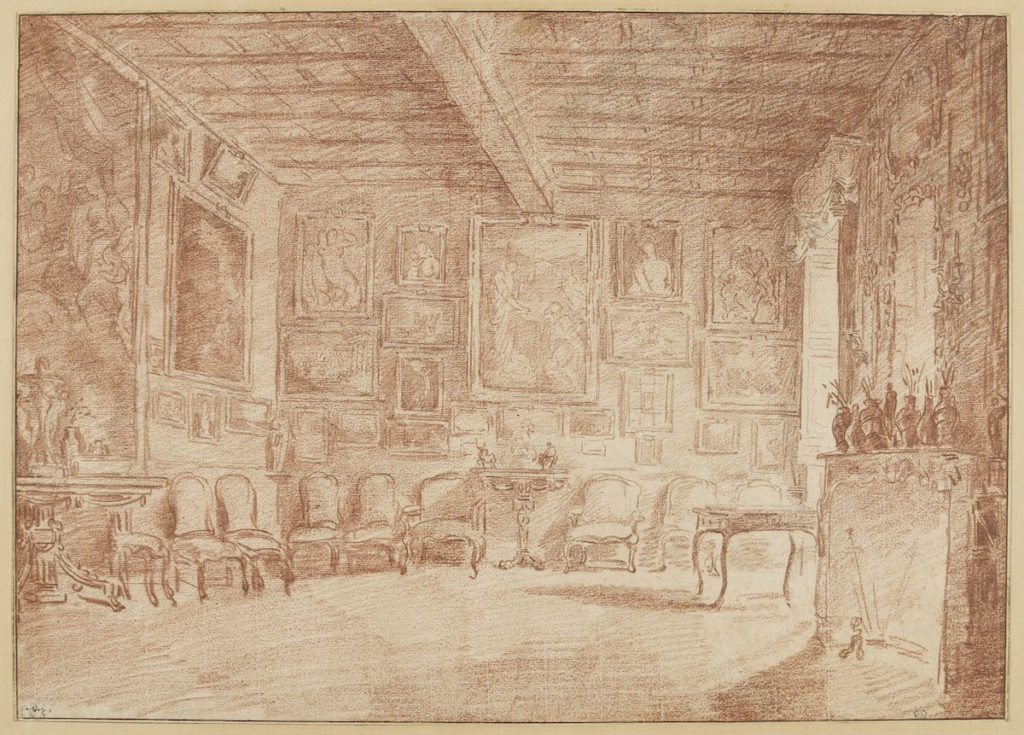
The concept of the autobiographical narrative is also helpful to grasp how The Artist in His Cell occupies a space where the genre scene and the self-portrait coexist. In her essay on Robert’s prison drawings, Catala, who describes The Artist in His Cell as a “self-portrait,”[55] writes that “the experience of confinement compelled Hubert Robert to undertake an introspection that certainly reveals as never before his most intimate thoughts,” thus assimilating Robert’s prison drawings to an “autobiographical process.”[56] Considering the nature of Robert’s self-inscription in The Artist in His Cell discussed in this article, the term “introspection” in the case of our drawing pertains specifically to Robert’s reflection on the transformation of his artistic identity during the Terror. This reflection manifests itself through the multiple ways in which the artist articulates his self on the page, that is, not only through the image of the immobilized artist, but also through the unsteady drawing, the lack of contrast between the artist and the setting, and the nature of the signature. Jean Starobinski’s remark about Rousseau’s conviction that the autobiography, including his own Confessions, functions as a self-portrait eloquently captures the most meaningful link between The Artist in His Cell and self-portraiture. Starobinski writes:
There is no such thing as a self-portrait that is not a good likeness, because “likeness” is not in the quality of the represented image but a matter of the self’s [sic] being present within the medium of representation [parole]. A self-portrait is not a more or less faithful copy of a subject called “the self.” It is a vital record of a search to discover the self.[57]
The French terms “trace vivante” in the original text, literally “living trace,” instead of “vital record,” help seize more explicitly the connection between Starobinki’s analysis of Rousseau’s understanding of the self-portrait and The Artist in His Cell as a drawing participating in self-portraiture as an “action”—another term that appears in the French text. For these terms invite us to look beyond the objects represented in the drawing to consider instead the artist’s touch—the equivalent here of Rousseau’s parole.[58] The Artist in His Cell, shaped by Robert’s intimate relationship with the Terror, runs counter to the artist’s earlier sense of self as a creative individual; and the drawing is the living trace, in the most embodied sense of the term, from which this earlier sense of self, notwithstanding its persistence, was profoundly transformed during Robert’s captivity.
Frédérique Baumgartner is Lecturer
and Director of the MA in Art History in the Department of Art History and
Archaeology at Columbia University
Acknowledgements: I wish to thank Melissa Hyde and Hannah Williams for their great help during the preparation of this article, as well as the anonymous reviewers for their extremely thoughtful remarks on an earlier version of the text.
[1] The drawing is also known as Hubert Robert in His Cell at Sainte-Pélagie. The title The Artist in His Cell corresponds to the French title L’Artiste dans sa cellule used in Hubert Robert 1733-1808. Un peintre visionnaire, exhib. cat. (Paris: Musée du Louvre, 2016), 400. Unless otherwise noted, all translations from the French are my own.
[2] Hubert Robert, exhib. cat. (Washington, D.C.: National Gallery of Art, 2016), 77. The Musée du Louvre and the National Gallery of Art organized the 2016 Hubert Robert exhibition together; however, each institution published its own catalogue. Catherine Voiriot’s biographical chronology, published in full in the Louvre catalogue, is included in a condensed form in the National Gallery catalogue.
[3] The preface of Jean-Clément Martin in Sophie de Bohm, Prisonnière sous la Terreur. Mémoires d’une captive en 1793 (Paris: Cosmopole, 2001), 3, indicates that an estimated 500,000 people were incarcerated at some point during the revolutionary decade (1789-1799). This implies that at least a couple of hundreds of thousands were arrested and imprisoned during the Terror.
[4] Robert was received at the Royal Academy of Painting and Sculpture on July 26, 1766 as “peintre d’architecture.”
[5] See Ewa Lajer-Burcharth, Necklines. The Art of Jacques-Louis David after the Terror (New Haven and London: Yale University Press, 1999), 33-47.
[6] At the time of Robert’s captivity at Sainte-Pélagie, prisoners could have food, furniture, books, etc., delivered to them from the outside, hence Robert’s access to his drawing materials. However, it is difficult to assess the conditions of detention in the prisons of the Terror, for testimonies are often contradictory. It does appear, however, that significant restrictions on the prisoners’ conditions of detention were enforced about two months before the fall of Robespierre. On this topic, see the preface by Martin in Bohm, Prisonnière sous la Terreur, 3-22, and Olivier Blanc, La Dernière Lettre. Prisons et condamnés de la Révolution 1793-1794 (Paris: Éditions Robert Laffont, 1984), especially the first two chapters.
[7] “Tu ne peux voir ma cellule, et tu veux la connaître. Je vais essayer de te la montrer.” Jean-Antoine Roucher, Consolations de ma captivité, ou Correspondance de Roucher, mort victime de la tyrannie décemvirale, le 7 thermidor, an 2 de la République française (Paris: H. Agasse, 1797), 53. Roucher’s extensive prison correspondence shows that exchanging letters with family members and friends was permitted. Only one personal letter written by Robert during his imprisonment is known (it was addressed to Roucher’s daughter Eulalie).
[8] The letter reads: “Je guêtais [sic] depuis plus de cinq semaines la chambre que j’ai. Elle m’est échue, et je m’y trouve aussi bien qu’on peut se trouver en prison … Je suis pavé en pierres de dalles … Je t’ai demandé une chaise de paille; je t’en demande deux; j’ai place pour elles, et mon lit est trop haut aujourd’hui pour que j’en fasse, comme auparavant, un canapé aux visitans [sic]” (“I had been awaiting for more than five weeks for the room I have. It was given to me, and I am here as well as one can be in prison … I am paved in stone slabs … I asked you for a straw chair; I am now asking you for two; I have room for them, and my bed is now too high for me to use it, as before, as a couch for visitors.”) Roucher, Consolations, 53-54.
[9] Alan Wintermute identified the figure in this painting as Roucher in 1789: French Art During the Revolution, exhib. cat (New York: Colnaghi, 1989), 274-277, thus rejecting its prior identification as Camille Desmoulins. Wintermute titles the painting Jean-Antoine Roucher (1745-1794) As He Prepares to Be Transferred from Sainte-Pélagie to Saint-Lazare, an episode that took place in the night of January 30 to 31, 1794, and that is recounted by Roucher in his correspondence published in 1797. Robert was transferred to Saint-Lazare that same night. As a result, Wintermute considers c. 1797 for the making of the painting, assuming that Robert based his composition on his reading of that letter. The website of the Wadsworth Atheneum Museum of Art, where the painting hangs today, also dates the painting to c. 1797; however, the title is simply Jean-Antoine Roucher in Prison. The date 1793-1794 seems more plausible to me, as it seems unlikely that Robert would return to prison subject matter three years after his incarceration ended. It is also worth mentioning for the contextualization of this painting that detainees were allowed to leave their cells and circulate freely within the prison. This certainly contributed to the development of Robert and Roucher’s friendship. According to Antoine Guillois, the two already knew each other before the Revolution. See Guillois, Pendant la Terreur. Le poète Roucher (Paris: Lévy, 1890), 202.
[10] Lajer-Burcharth, Necklines, 33.
[11] Sarah Catala makes a similar point about the prison works, emphasizing that in addition to conveying his experience of the present, Robert put aside the representation of monuments to foreground instead the representation of people. Catala, “‘Carcer Socratis Domus Honoris.’ Les dessins d’Hubert Robert dans les prisons de la Terreur,” in Louis-Antoine Prat and Pierre Rosenberg, eds., De David à Delacroix. Du tableau au dessin. Onzièmes rencontres internationales du Salon du dessin, 30 et 31 mars 2016 (Paris: Société du Salon du dessin and Dijon: Échelle de Jacob, 2016), 38.
[12] Étienne Vigée’s obituary of Robert states that by the time he was released from prison, Robert “avait fait cinquante-trois tableaux, sans compter une prodigieuse quantité de dessins” (“had done fifty-three paintings, not to mention a prodigious number of drawings”). Vigée, “Notice nécrologique: Hubert Robert,” Mercure de France 32 (April 1808), 231. It is not clear, however, how Vigée arrived at a total of 53 paintings. To date, the major reference for Robert’s prison oeuvre remains Hubert Robert et la Révolution, exhib. cat.(Valence: Le Musée de Valence, 1989). Furthermore, Paula Radisich’s epilogue in Hubert Robert: Painted Spaces of the Enlightenment (Cambridge: Cambridge University Press, 1998) offers a critical account of a small selection of Robert’s prison works. A section of Un peintre visionnaire addresses them as well, with Catala and Voiriot as co-authors of the entry for The Artist in His Cell, whose scope is largely expanded by Catala in her separate essay “‘Carcer Socratis Domus Honoris.’” Finally, Sophie Matthieson has conducted research on Robert’s prison oeuvre as part of her dissertation The Prison-Made Object in the French Revolution (Monash University, 2016). While a catalogue raisonné of Robert’s prison oeuvre has yet to be published, we know that the artist produced many drawings (using watercolor and/or chalk), as well as oil paintings of variable dimensions and painted plates, during this period. His subject matter not only included scenes pertaining to prison life, but also imaginary scenes that function as meditations on the course of the Revolution, as well as landscapes.
[13] For example, according to Margaret Grasselli, the drawing from the Albertina in Vienna that has long been known as The Sleep of Marat is actually not a representation of l’ami du peuple. Grasselli titles it instead A Prison Warden Sleeping in Hubert Robert, exhib. cat. (Washington), 249.
[14] Charlotte Guichard, La Griffe du peintre. La valeur de l’art (1730-1820) (Paris: Seuil, 2018), 147.
[15] Un peintre visionnaire, 400; and Catala, “‘Carcer Socratis Domus Honoris,’” 41. My English translations of the inscriptions are based on Catala and Voiriot’s French translations from the Latin versions.
[16] This sketch is not dated by Robert; however, the inclusion of that same group of figures on the far right of the painting entitled Demolition of the Château of Meudon (Los Angeles, The J. Paul Getty Museum), dated 1806, suggests that the sketch was done around that same time.
[17] Interestingly, the recognition of “Robert the artist at work” as a signature motif in his oeuvre is reflected in the inventory made after the death of the artist’s widow, dated August 18, 1821. In it, the works of art authored by Robert are identified through a brief description of the subject matter, followed by a price. Under number 288, we find a picture “où l’on voit M. Robert occupé à dessiner. Prisé 20 fr.” (“where we see M. Robert busy drawing. Priced 20 francs”). Reproduced in Cyrille Gabillot, Hubert Robert et son temps (Paris: Librairie de l’art, 1895), 254.
[18] Un peintre visionnaire, 164.
[19] This self-representation of Robert resonates strongly with Melissa Hyde’s reading of a work by François Boucher, in which Robert’s elder and occasional collaborator also depicted himself drawing in his studio. Hyde qualifies the work as “a figuration of his [Boucher’s] artist-self (rather than an actual likeness), the image of the inspired young artist.” Hyde, “Getting into the Picture: Boucher’s Self-Portraits of Others,” in Melissa Hyde and Mark Ledbury, eds., Rethinking Boucher (Los Angeles: Getty Research Institute, 2006), 21.
[20] In her study on Academicians’ portraits, Hannah Williams observes that artistic attributes are usually represented in close proximity to the artist’s body. In this context, Robert’s turning of his back to his portfolio can be read as a departure from a larger tradition of artists’ portraits. See Williams, Académie Royale. A History in Portraits (London and New York: Routledge, 2015).
[21] “L’écriture se trouve à la fois activée et bornée par l’enfermement.” Daniel Sangsue, Le Récit excentrique. Gautier, De Maistre, Nerval, Nodier (Paris: Librairie José Corti, 1987), 164. For Paula Radisich, it is fair to state that “Robert quite consciously turned his cell into a site of art production.” Radisich, Painted Spaces, 121. This seems to have been less the case at Sainte-Pélagie than at Saint-Lazare, where Robert had a bigger cell that allowed him to paint large canvases. The few comments on Robert that were passed on by his prison mates, including Roucher, the antiquarian Aubin-Louis Millin, and Robert’s former commissioner Charles-Louis Trudaine de Montigny, all allude to the artist’s steady work in captivity. In a letter to his sister written from Saint-Lazare, Trudaine wrote “Robert demeure vis-à-vis dans un superbe atelier … Il fait un tableau à l’heure et auprès de sa diligence ma lenteur me désespère” (“Robert lives across [from me] in a superb studio … He makes one picture per hour and compared with his diligence my slowness drives me to despair”). Quoted in Léon Bizard, Histoire de la prison de Saint-Lazare du Moyen Age à nos jours (Paris: E. de Boccard, 1925), 152.
[22] Lajer-Burcharth refers to Beverly Schreiber Jacoby’s use of the expression “wall power” to emphasize that from the 1730s, “[François] Boucher began adapting his style to enhance the display quality.” Lajer-Burcharth, The Painter’s Touch. Boucher, Chardin, Fragonard (Princeton and Oxford: Princeton University Press, 2018), 24.
[23] The letter was first published by M. E. Sainte-Beuve, “Le peintre Hubert Robert sous la Terreur,” Beaux-Arts (May 15, 1927), 147-149.
[24] The sketches have disappeared. It is assumed that Robert never painted the large canvases since his request was not granted; however, I believe that the painting sold at Christie’s New York on January 28, 2009 under the title The Park at Ermenonville, signed H. Robert Pictor in St Lazare, could potentially be the painting of Bara, as Robert intended the latter to show the boy’s tomb surrounded by cypresses. The Park at Ermenonville features precisely these motifs.
[25] “Amour de l’humanité, liberté, égalité, animez mes pinceaux.” Rapport et décret sur la fête de la Réunion républicaine du 10 Août, présentés par David, Député du Département de Paris (Paris: Convention Nationale, 1793), 2.
[26] On December 3, 1793, about two months prior to Robert’s letter, the member of the Convention Lindet was asked by the Committee of Public Instruction to put together a list of all the names of revolutionary martyrs, as a reference of subjects for artists. Though Lindet completed his task on May 2, 1794, Robert must have been aware of the government’s expectations, and of course knew David’s Death of Marat, to which he alludes in his letter.
[27] The drawing The Sleep of Marat, which features a piece of paper on which one can read “dénonciat[ion] de Robert par Beaudouin” (“denunciation of Robert by Beaudoin”), a name that indeed appears on Robert’s warrant, indicates that the artist condemned current practices; however, this should not be equated with a condemnation of the Revolution as a larger project of transformation of Ancien Régime society.
[28] Robert followed the Gregorian calendar instead of the revolutionary calendar. Considering that the latter had just been adopted (October 5, 1793), it seems difficult to ascribe a specific meaning to Robert’s use of the traditional calendar.
[29] Amy Freund, “The Citoyenne Tallien: Women, Politics, and Portraiture during the French Revolution,” The Art Bulletin 93:3 (September 2011), 333.
[30] Freund, “The Citoyenne Tallien,” 323.
[31] In Portraiture and Politics in Revolutionary France (University Park, PA: The Pennsylvania State University Press, 2014), Amy Freund implies that during the Terror, portraiture’s role in affirming political sovereignty was compromised. Indeed, this period is not treated as a chapter in the book, but as an interruption in the narrative, caught between the first three chapters and last three chapters.
[32] Freund, “The Citoyenne Tallien,” 337.
[33] Robert sold some of his prison works at the time of his captivity, including the painted plates; however, he also gave some as gifts to fellow inmates, and kept some for himself, as the catalogue of the sale of his art collection held on April 5, 1809, indicates: under number 265 are listed “trois autres dessins légèrement coloriés, dont un fait dans la prison de Sainte-Pélagie” (“three additional drawings slightly colored, including one made in the Sainte-Pélagie prison”). Reproduced in Gabillot, Hubert Robert, 268. We cannot exclude that this drawing was The Artist in His Cell. The fact that Robert never showed his prison works at the Salon differentiates him from his colleague Joseph-Benoît Suvée. The portraits of the prisoners who sat for Suvée in Saint-Lazare, where he was himself held captive before they were taken to the guillotine, were exhibited at the Salon of 1795, as Tony Halliday has discussed in Facing the Public. Portraiture in the Aftermath of the French Revolution (Manchester and New York: Manchester University Press, 1999), 76-82.
[34] See note 8.
[35] There is currently no explanation for the gap between the date of the warrant and the date of Robert’s actual incarceration at Sainte-Pélagie.
[36] “Son incivisme reconnu, ses liaisons avec les aristocrates.” Cited in Un peintre visionnaire, 496. This important document was first mentioned in the 2016 Louvre catalogue, refuting what earlier sources had identified as the official reason for Robert’s arrest, namely, his failure to renew his civic certificate (a reason for arrest according to the Law of Suspects). My own research has led me to identify the Almanach des prisons ou Anecdotes sur le régime intérieur de la Conciergerie, du Luxembourg, etc. et sur différens [sic] prisonniers qui ont habité ces maisons sous la tyrannie de Robespierre, avec les chansons, couplets qui y ont été faits (Paris: Michel, Year III), as the source responsible for the confusion about the official reason for Robert’s arrest. This sarcastic account reads: “Une chose assez comique, c’était les écrous. Ici on lisait: Vivian, perruquier, prévenu d’imbécillité et de peu de civisme … Là, Robert, pour avoir négligé de renouveler sa carte de citoyen” (“One quite amusing thing was the warrants. Here one would read: Vivian, wigmaker, accused of imbecility and lack of civic mindedness … There, Robert, for having failed to renew his citizen certificate”). This information was then reused by Guillois, and later by M.E. Sainte-Beuve.
[37] The text of the decree is available at https://gallica.bnf.fr/ark:/12148/bpt6k96798386/f3.item (accessed September 10, 2019).
[38] See Jean de Cayeux, with the collaboration of Catherine Boulot, Hubert Robert (Paris: Fayard, 1989), 272.
[39] Hubert Robert et la Révolution, 11.
[40] Robert had purchased a country house in Auteuil in 1778. The report from the Committee of Surveillance reads: “Nous avons vu [Robert] quelquefois avec des artistes, [à] savoir Clérisseau, dessinateur, et d’autres dont les noms nous sont inconnus … Nous n’avons rien pu observer sur son caractère et ses opinions … Les motifs [de son arrestation] nous sont inconnus” (“We have seen Robert with artists from time to time, including Clérisseau, draughtsman, and others whose names are unknown to us … We have not been able to observe anything about his character and his opinions … The reasons for his arrest are unknown to us”). Cited in Ferdinand Boyer, “Hubert Robert dans les prisons de la Terreur d’après le fonds des Archives Nationales,” Bulletin de la Société de l’Histoire de l’Art Français (1963), 388.
[41] “Constamment manifesté leur attachement à la révolution.” “Ennemis de la liberté.” See note 37 for the link to the decree.
[42] Susan Carpenter Binkley, The Concept of the Individual in Eighteenth-Century French Thought from the Enlightenment to the French Revolution (Lewiston, N.Y. and Queenston, Ontario: The Edwin Mellon Press, 2007), 60.
[43] Binkley, The Concept of the Individual, 8. Binkley goes on to discuss the committees of surveillance, comparing them to the panopticon. However, this model should not be extended to the functioning of the prisons of the Terror, which were profoundly disorganized, as Jean-Clément Martin has noted. This disorganization might have been an effect of the large number of prisoners (about 80,000 during the Great Terror of the Summer of 1794). Most importantly, it contradicts the idea of the prisons as a site of “machinerie idéologique” (“ideological machinery”). See Martin’s preface in Bohm, Prisonnière sous la Terreur, 3-4.
[44] For a history of the identification of individuals in France, including the rationalization of techniques of individuals’ physical description in the course of the eighteenth century and eventual systematization of these techniques at the beginning of the nineteenth century, see Vincent Denis, Une histoire de l’identité: France, 1715-1815 (Seyssel: Champ Vallon, 2008). Richard Taws’ The Politics of the Provisional: Art and Ephemera in Revolutionary France (University Park, PA: The Pennsylvania State University Press, 2013) also offers a critical discussion of identity papers during the French Revolution, including passports’ relationship with both the well-established genre of portraiture and the expanding revolutionary paper culture, exemplified by the assignat.
[45] Binkley, The Concept of the Individual, 66.
[46] For example, Roucher refers to “le citoyen Robert” in his letters dated 23 Nivôse Year II, 26 Nivôse Year II, and 11 Pluviôse Year II. Roucher, Consolations, 144, 163, and 248.
[47] Un peintre visionnaire, 400. The meaning of Robert’s use of his civil signature in The Artist in His Cell is further discussed by Catala in “‘Carcer Socratis Domus Honoris,’” 39. According to her, Robert depicted himself in the drawing as a painter, a political prisoner, and a citizen. While I agree with Catala that the placement of the signature on the portfolio emphasizes Robert’s condition as an imprisoned artist and that his use of his civil signature is a comment on his status as a citizen, I do not believe that Robert portrays himself as a “political prisoner,” considering the neutrality of the drawing as far as commenting on politics per se is concerned. In contrast, Robert’s civil signature appearing on the petition addressed to the Directory on 26 Thermidor Year IV (August 13, 1796) against the displacement of works of art following Bonaparte’s Italian campaign, reproduced in Guichard, La Griffe du peintre, 155, speaks to Robert’s political engagement when it came to cultural issues. This is consistent with the nature of the revolutionary episodes that he chose to depict between 1789 and 1799, namely episodes that embodied the Revolution’s effort to transform the cultural sphere, as I have argued in my dissertation Transformation of the Cultural Experience. The Art of Hubert Robert during the French Revolution (Harvard University, 2011).
[48] Taws, The Politics of the Provisional, 58.
[49] “Un élément clé de la fabrique du nouveau citoyen.” Guichard, La Griffe du peintre, 261.
[50] Philippe Bordes, “La recherche sur l’art de la Révolution française. Le tournant du bicentenaire,” in Jean-Clément Martin, ed., La Révolution à l’oeuvre: Perspectives actuelles dans l’histoire de la Révolution française. Actes du colloque de Paris, 29, 30, et 31 janvier 2004 (Rennes: Presses universitaires de Rennes, 2005), 257.
[51] “Pour consommer le projet de tarir toutes les sources de lumières, il fallait paralyser ou anéantir les hommes de génie.” Abbé Grégoire, “Rapport sur les destructions opérées par le vandalisme, et sur les moyens de le réprimer,” in Patrimoine et cité: textes choisis (Bordeaux: Confluences, 1999), 25.
[52] This report was presented on 24 Frimaire Year III (December 14, 1794). For the section on the “hommes à talents,” see Patrimoine et cité, 51.
[53] At the marquis de Girardin’s request, Robert designed in 1780 a tomb for Rousseau. It was meant to replace the initial funerary monument that was elevated on the Île des peupliers at the time of the philosopher’s death in 1778. Robert’s familiarity with Rousseau is further evidenced by the inventory after death of his widow, which lists 135 bound volumes of various formats, including works by Rousseau—the only author mentioned by name. See Archives nationales, ET/XIX/963 minutier central.
[54] “Tous ces détails, si ordinaires, semblent en effet éloigner le lecteur de la connaissance de cette personnalité extraordinaire qu’est Rousseau. Or le rapport entre le sujet central et l’objet secondaire ou pour le dire autrement entre le portrait et son décor est seulement déplacé […] Ces éléments du quotidien forment un tableau de genre et finissent par travailler à une sorte d’autoportrait.” Anne Chamayou, “Poétique du quotidien dans les dernières années de la correspondance de Rousseau,” in Eric Francalanza, ed., Rousseau en toutes lettres. Actes du colloque de Brest, 22-24 mars 2012 (Rennes: Presses Universitaires de Rennes, 2014), 329 and 332.
[55] Catala, “‘Carcer Socratis Domus Honoris,’” 39.
[56] “L’expérience de l’enfermement force Hubert Robert à opérer une introspection qui dévoile certainement comme jamais ses réflexions les plus intimes.” “Processus autobiographique.” Catala, “‘Carcer Socratis Domus Honoris,’” 38.
[57] Jean Starobinksi, Jean-Jacques Rousseau. Transparency and Obstruction, trans. Arthur Goldhammer (Chicago and London: The University of Chicago Press, 1988), 199. The French text reads: “Il n’y a pas d’autoportrait non ressemblant, car la ressemblance n’est nullement dans l’image représentée, mais dans la presence du moi à l’intérieur de la parole. L’autoportrait ne sera donc pas la copie plus ou moins fidèle d’un moi-objet, mais la trace vivante de cette action qu’est la recherche de soi.”
[58] My use of the term “artist’s touch” obviously brings to mind the title of Lajer-Burcharth’s latest book.
Cite this article as: Frédérique Baumgartner, “Hubert Robert in Prison: Self, Revolution, and the Contingencies of Artistic Inscription,” Journal18 Issue 8 Self/Portrait (Fall 2019), https://www.journal18.org/4374.
Licence: CC BY-NC
Journal18 is published under a Creative Commons CC BY-NC International 4.0 license. Use of any content published in Journal18 must be for non-commercial purposes and appropriate credit must be given to the author of the content. Details for appropriate citation appear above.
